May 9th, 2011
| 3 Comments »
May is looking a bit different around the kitchen. It’s a lot more green. And red. And purple. Don’t forget orange and yellow.
I was invited by Whole Foods to take part in a 28-day challenge of consuming a plant-based diet, based on the best-selling book The Engine 2 Diet, written by firefighter Rip Esselstyn, who designed the plan to help his fellow firefighters lose weight and combat health issues such as high cholesterol, diabetes and heart disease. Whole Foods will be introducing this challenge to it’s customers in June, and four local bloggers will be chronicling their 28 days for the Whole Foods clientele to read about as they move forward with their own 28 day plan.
Rip’s book outlines all the benefits of a plant-based diet, and includes great testimony from people who have successfully used the plan to lose weight, lower their cholesterol and reverse the devastating effects of diabetes and heart problems. The premise of it goes like this; no processed or packaged foods, no added salts, no animal products, and no fats at all, including all oils. What you eat is a wide variety of vegetables, fruits, whole grains and legumes. The book comes with an extensive recipe collection, all simple and straight forward. There’s no need for any special cooking skills, or equipment or tools or anything. Just cut out the junk, and ramp up the intake of the good stuff.
I was intrigued by the idea of it, and enjoyed reading Rip’s book, sent to me free by Whole Foods. He’s got a lot of really bare bones information about the state of our health in the United States, and I don’t need to tell you that it’s really not a pretty picture. And I’m not going to get into any details. We all know how bad it is, even if we make like we don’t notice. My family eats really healthy foods, and I’m pretty diligent about purchasing items that I am comfortable with giving to my guys, but I’m always willing to do more and this challenge is giving me an opportunity to step up our game. As I see it, with what we do already, we’re about halfway there anyway, so taking it to another level won’t be that difficult. I don’t need to lose much weight at all, but we both have a strong desire to be as healthy as we can possibly be, and Mike has had issues with high cholesterol.
One of the nice things about Rip’s approach is that it’s really a very open-minded explanation, and it leaves a lot for each individual to interpret on their own. His suggestion, obviously, is to jump right in and start on the challenge, but he readily acknowledges that it’s often a tough step to take, and offers readers several options for easing in to it, and really, the best advice he gives is that it’s really something you can custom tailor to your own needs. And that’s what I did for us. Mike and I easily can give up almost all of our meat consumption, and so that’s where I’m taking our challenge. With the exception of a few social events for me where I’ve eaten meat, our home meals have all been meat free. With the gift card that Whole Foods provided, I stocked up on grains, brown and wild rice, lots of colorful vegetables and fruits and we’ve been enjoying some pretty amazing meals with our bounty. I’m not on board with Rip’s assessment of cutting out fat consumption, as I am firm in my belief and understanding that good fats are a necessity in good body function, for your brain and your autonomic nervous system. We need fat, and although there are many ways to get good fat through plant-based eating, I’ve kept the olive oil, but cut out the butter. I’m already missing my weekly popcorn fix.
But it’s a good thing though; we can all stand to do something better for our health. This is giving us motivation, and incentive to push to another level. We love vegetables, thank goodness, and it’s coming to the best time of year for vegetable love in Minnesota, as the Farmers Markets open and the bounty starts pouring in. And I made an agreement with my meat-loving son; I won’t mind if he wants to fix himself a piece of chicken, or a small steak if he’s willing to really try some of the new foods that come out of the kitchen. He didn’t even hesitate before he said ‘Yes’.
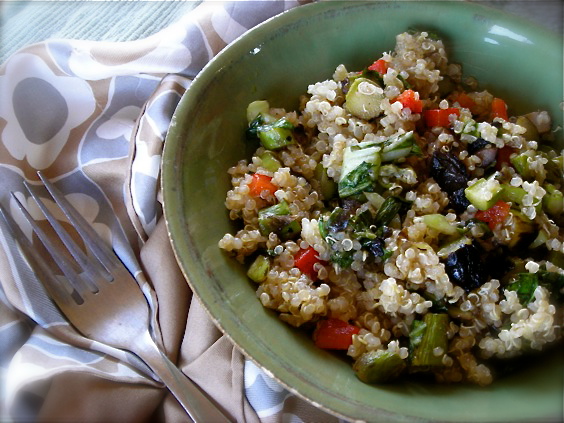
The first time Griffin tried quinoa he enjoyed it enough, even though he said the texture was ‘a little weird’. This time, when I loaded it with all sorts of grilled vegetables like baby bok choy, portabella mushrooms, red peppers and asparagus, he heaped his bowl full and really got into it. Upon finishing it, he sighed deeply and said to me “You know, that’s surprisingly filling.”
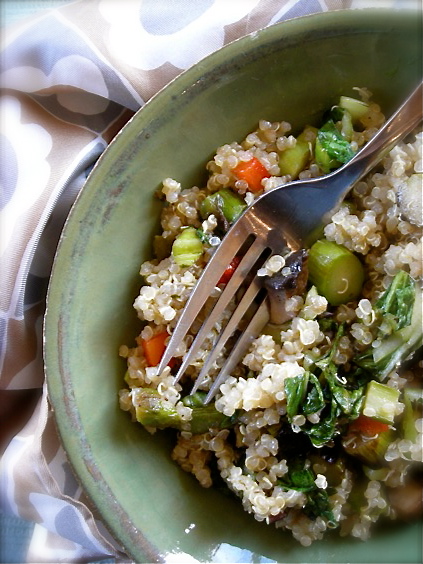
I don’t really have a ‘recipe’ for this. I made a simple balsamic vinaigrette that I brushed on the vegetables, then I grilled them, chopped them up and mixed them with cooked quinoa, salt and pepper. It was really delicious, and yes, it was surprisingly filling. Quinoa cooks in about 15 minutes and it goes with everything. If you haven’t tried this super little grain, I can’t recommend it enough.
Stay tuned for more posts about the E2 challenge!
Disclaimer:
Whole Foods provided the book and a gift card free of charge to me for agreeing to participate in the Engine 2 Challenge.
All opinions expressed here are mine.
March 3rd, 2010
| 13 Comments »
What’s that, you say? Ajvar? Is it AHJ-VAR? AGG-VAR? How do you say it?? And what the heck is it?!?
It’s delicious, delightful, piquant, sweet and when spread on a toasted pita, a tiny slice of food heaven. The origin is Balkan in nature, and it shares it’s etymology with caviar, although there is no fish roe involved.
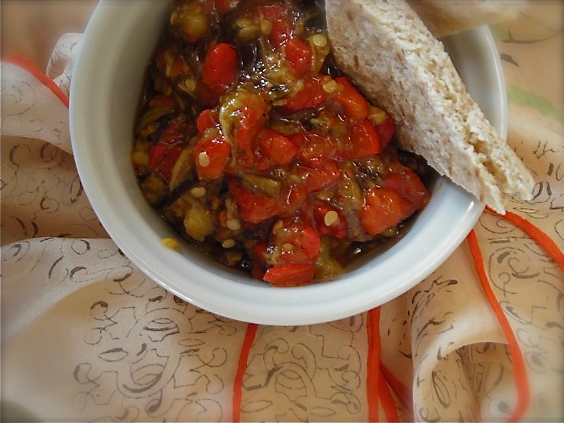
And it’s pronounced EYE-VAR. As with most foods that pass through this little blog of mine, it has a story. A pricey one. And it goes like this.
I love ethnic foods, and the more eclectic and unique the ethnicity is, the better I like it. I’m happy to browse any manner of unusual food market I come across, my eyes trailing the shelves, fingering the ingredients found there and trying to determine if I know what is is, first and foremost, and if I can take it home and use it. I am so blessed to live in a very culturally diverse city, and within many channels and pockets of the population one can find amazing stores full of ingredients that will elevate simple home dining. In the middle eastern market that I frequent in Columbia Heights, where the pita bread is often so fresh that the bags are still warm, I came across a jar of a bright red condiment that caught my eye. Roasted red peppers, roasted eggplant, garlic, oil. Oh my, what’s not to love? Despite the hefty price tag, I took one home. Big mistake.
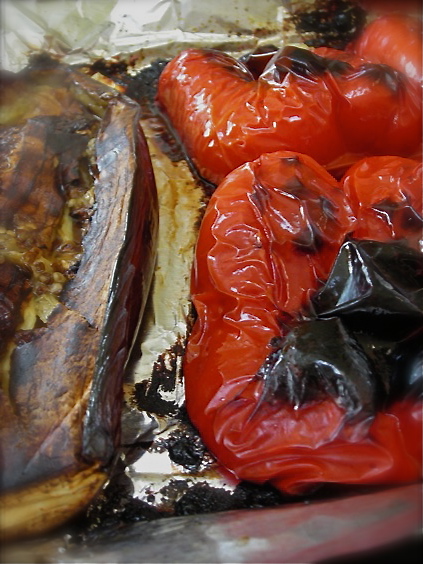
I toasted some of that wonderful pita bread and slipped it through the bowl of bright red Ajvar in front of me, lifting it to my mouth. I was lost. I fell hard and fast for this sweet, somewhat spicy and cool relish. Mixed with a bit of plain yogurt, I could eat it night or day. And I did. I made pilgrimages back to that market for more bread, for more Ajvar. The price always got me, but I forged on. I loved the stuff. But like all good things, bested as they can be by economic downturn, I had to suspend my tastebuds desire for it and stop driving back to that store to buy another jar.
But I didn’t forget. There would be a day to enjoy it again. I was certain of it.
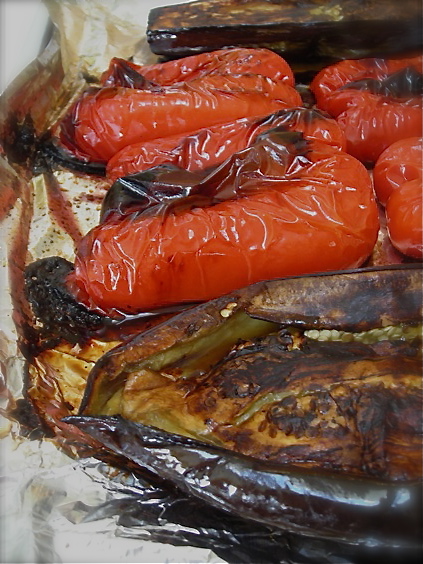
Like for many, that economic downturn hasn’t really let up it’s grip on us, and being the case, I’ve yanked up the bootstraps and found ways to further stretch the dollars and yet not go without some of the foods I really love. But it took coming across a superbly simple recipe for Ajvar to prompt me into actually making this at home.
What could be simpler than roasting vegetables to a nice rich blackened state and running my big knife over them? Because, you know, when looking at this, I yet again get that feeling that I wish I hadn’t waited so long.
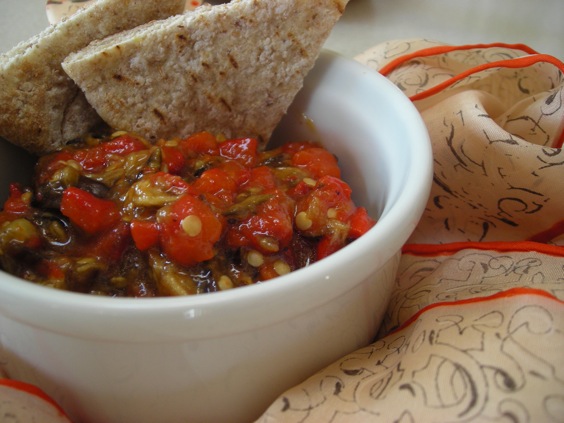 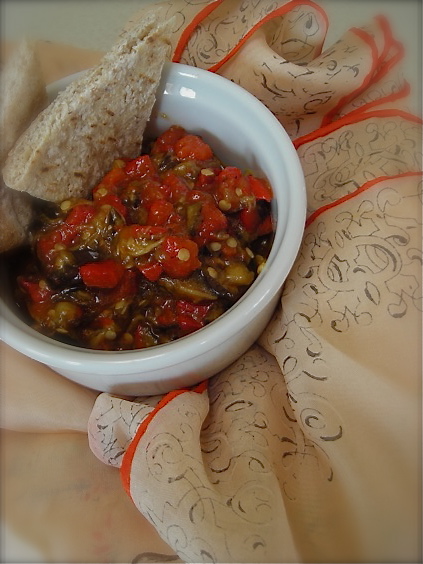
Ajvar
recipe source unknown (somewhere in Internet land)
1 large eggplant, sliced in half the long way
2 red bell peppers, split in half and de-seeded
2-4 garlic cloves (optional)
Preheat oven to 450° and adjust one rack to the lowest level in your oven. Cover a baking sheet with foil and spray the foil with cooking spray. Place the vegetables cut side down on the sheet and lightly mist the tops with cooking spray. This is optional, but I find it helps with the charring.
Roast the vegetables on the lowest rack until the tops of the peppers are black and wrinkly, and the eggplant has softened. Depending on your oven, this could take anywhere from 15-30 minutes, or maybe more. Check regularly to monitor. If your house is like mine, you may need to de-activate your smoke detector. This is a fragrant and hot process.
Remove the sheet when the veggies are ready and allow to cool completely. At this point, you can either place them in a food processor to blend, or simply mince them on a cutting board. I used the cutting board and my big chef’s knife. It took me about 2 minutes. Place minced veggies in a bowl, add about 1/4 cup of good quality olive oil, and then season to taste with salt and pepper. If you want it spicy, feel free to add crushed red pepper, or if you can find it, ground szechuan peppercorns would be amazing in this. I prefer mine on the mild side. It can be served room temperature, but the flavor will develop after a day or two in the fridge.
Eat it with toasted pita, carrots, or spread on hearty crackers. It tastes wonderful when mixed with a little plain yogurt too. I also think it would be delicious served over pasta.
May 27th, 2008
| 7 Comments »
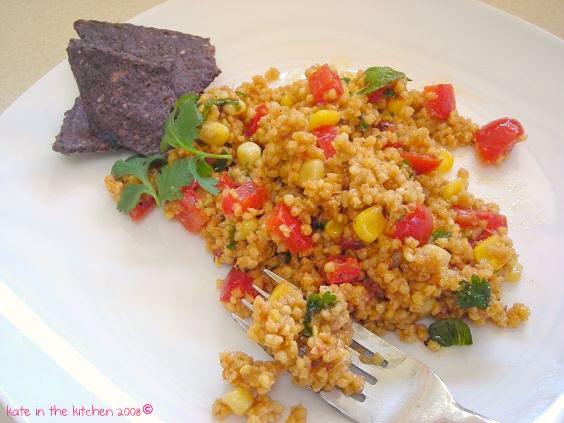
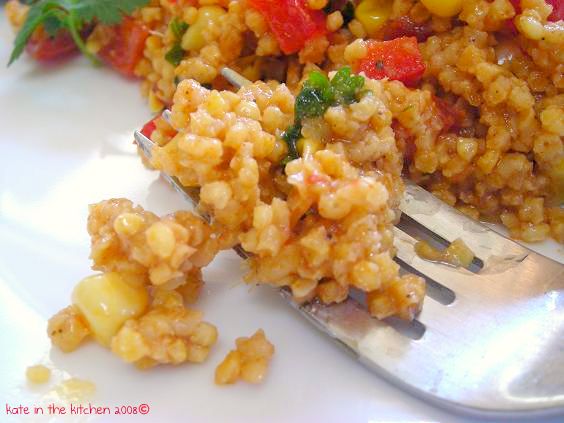
African Millet Salad with Corn and Peppers
from The New Whole Grains Cookbook by Robin Asbell
3 T. olive oil
1 medium onion, julienned
2 T. chopped garlic
2 T. minced ginger
1 T. paprika
1 t. black pepper
1/8 t. ground allspice
1/8 t. cayenne pepper, or to taste
1 c. millet
1 t. salt
1/4 c. lemon juice
1 T. brown sugar
1 8-oz can extra crunchy corn
1 small green bell pepper, chopped
1 roma tomato, chopped
1/4 c. parsley, chopped
1/4 c. roasted peanuts, chopped
In a 2-qt saucepan with a tight fitting lid, heat 1 T. of oil and saute onion until golden. Add garlic and ginger and cook for one minutes, then add paprika, black pepper, allspice, and cayenne and cook for one minute more. Wash millet quickly and drain; add to pan and stir, coating grains and cooking until hot to the touch. Add water and salt and bring to boil, then reduce heat and simmer on low for 20 minutes before checking for doneness**. When all liquid is absorbed and grain is tender, cover and remove from heat, allowing to steam for 10 minutes. Scrape millet into bowl and cover, then let cool. Whisk remaining oil with lemon juice and brown sugar in a small bowl. Stir corn, bell pepper, tomato and parsley in with the millet, then drizzle dressing over and stir to coat. Serve topped with peanuts.
KATE’S NOTES:
I used cilantro in place of parsley as I had it on hand; a red bell pepper instead of a green (don’t care for green) and frozen corn instead of canned.
**Despite following the cooking instructions faithfully, the grain, I felt, came out to be a little chewier than I expected and being unfamiliar with it, I contacted the cookbook author to ask her opinion on the texture. Her response was that millet can often be confounding in that way, and the amount of water listed in the recipe can sometimes be less than needed and other times it’s just enough. She feels this is simply one aspect of the grain’s natural humidity level, and can be adjusted during the final cooking stages. Once the grain has absorbed all the water, she suggested to quickly stir and remove a few pieces to test for tenderness, and if it is still firm and chewy to add in a little more water- 1/4 to 1/2 cup- quickly bring the temperature back to boiling, then reduce and simmer again for another 10 minutes.
|








